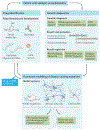Drug development in the era of precision medicine
- PMID: 29217837
- PMCID: PMC6287751
- DOI: 10.1038/nrd.2017.226
Drug development in the era of precision medicine
Abstract
For the past three decades, the use of genomics to inform drug discovery and development pipelines has generated both excitement and scepticism. Although earlier efforts successfully identified some new drug targets, the overall clinical efficacy of developed drugs has remained unimpressive, owing in large part to the heterogeneous causes of disease. Recent technological and analytical advances in genomics, however, have now made it possible to rapidly identify and interpret the genetic variation underlying a single patient's disease, thereby providing a window into patient-specific mechanisms that cause or contribute to disease, which could ultimately enable the 'precise' targeting of these mechanisms. Here, we first examine and highlight the successes and limitations of the earlier phases of genomics in drug discovery and development. We then review the current major efforts in precision medicine and discuss the potential broader utility of mechanistically guided treatments going forward.
Conflict of interest statement
Competing interests statement
The authors declare
Figures


References
-
- National Research Council (US) Committee on A Framework for Developing a New Taxonomy of Disease Toward Precision Medicine: Building a Knowledge Network for Biomedical Research and a New Taxonomy of Disease (National Academies Press, 2011). - PubMed
-
- Raviña Rubira E The Evolution of Drug Discovery: From Traditional Medicines to Modern Drugs. (Wiley-VCH, 2011).
-
- Zanders ED The Science and Business of Drug Discovery. (Springer, 2011).
-
- Hopkins MM, Martin PA, Nightingale P, Kraft A & Mahdi S The myth of the biotech revolution: an assessment of technological, clinical and organisational change. Res. Policy 36, 566–589 (2007).
-
- Nightingale P & Madhi S in Knowledge Accumulation and Industry Evolution: The Case of Pharma-Biotech (eds Mazzucatu M & Dosi G) 73–111 (Cambridge Univ. Press, 2006).
Publication types
MeSH terms
Substances
Grants and funding
LinkOut - more resources
Full Text Sources
Other Literature Sources
Medical
Miscellaneous

